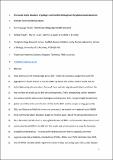Files in this item
Fine-scale depth structure of pelagic communities throughout the global ocean based on acoustic sound scattering layers
Item metadata
| dc.contributor.author | Proud, Roland | |
| dc.contributor.author | Cox, Martin | |
| dc.contributor.author | Le Guen, Camille | |
| dc.contributor.author | Brierley, Andrew Stuart | |
| dc.date.accessioned | 2019-06-27T23:41:20Z | |
| dc.date.available | 2019-06-27T23:41:20Z | |
| dc.date.issued | 2018-06-28 | |
| dc.identifier | 252985223 | |
| dc.identifier | 632de605-4bfc-46c0-b842-c7a924bfed40 | |
| dc.identifier | 85049248110 | |
| dc.identifier | 000438415600003 | |
| dc.identifier.citation | Proud , R , Cox , M , Le Guen , C & Brierley , A S 2018 , ' Fine-scale depth structure of pelagic communities throughout the global ocean based on acoustic sound scattering layers ' , Marine Ecology Progress Series , vol. 598 , pp. 35-48 . https://doi.org/10.3354/meps12612 | en |
| dc.identifier.issn | 0171-8630 | |
| dc.identifier.other | ORCID: /0000-0002-8647-5562/work/44362052 | |
| dc.identifier.other | ORCID: /0000-0002-6438-6892/work/60427322 | |
| dc.identifier.uri | https://hdl.handle.net/10023/17997 | |
| dc.description.abstract | Most multicellular biomass in the mesopelagic zone (200-1000 m) comprises zooplankton and fish aggregated in layers known as sound scattering layers (SSLs), which scatter sound and are detectable using echosounders. Some of these animals migrate vertically to and from the near surface on a daily cycle (diel vertical migration, DVM), transporting carbon between the surface and the deep ocean (biological carbon pump, BCP). To gain insight into potential global variability in the contribution of SSLs to the BCP, and to pelagic ecology generally (SSLs are likely prey fields for numerous predators), we investigated regional-scale (90000 km2) community depth structure based on the fine-scale (10s of m) vertical distribution of SSLs. We extracted SSLs from a near-global dataset of 38 kHz echosounder observations and constructed local (300 km × 300 km) SSL depth and echo intensity (a proxy for biomass) probability distributions. The probability distributions fell into 6 spatially coherent regional-scale SSL probability distribution (RSPD) groups. All but 1 RSPD exhibited clear DVM, and all RSPDs included stable night-time resident deep scattering layers (DSLs: SSLs deeper than 200 m). Analysis of DSL number and stability (probability of observation at depth) revealed 2 distinct DSL types: (1) single-shallow DSL (a single DSL at ca. 500 m) and (2) double-deep DSL (2 DSLs at ca. 600 and 850 m). By including consideration of this fine-scale depth structure in biogeographic partitions and ecosystem models, we will better understand the role of mesopelagic communities in pelagic food webs and the consequences of climate change for these communities. | |
| dc.format.extent | 1329324 | |
| dc.language.iso | eng | |
| dc.relation.ispartof | Marine Ecology Progress Series | en |
| dc.subject | Biogeography | en |
| dc.subject | Diel vertical migration | en |
| dc.subject | DVM | en |
| dc.subject | Acoustics | en |
| dc.subject | Water column | en |
| dc.subject | Deep scattering later | en |
| dc.subject | DSL | en |
| dc.subject | Mesopelagic | en |
| dc.subject | GC Oceanography | en |
| dc.subject | QH301 Biology | en |
| dc.subject | NDAS | en |
| dc.subject | SDG 13 - Climate Action | en |
| dc.subject.lcc | GC | en |
| dc.subject.lcc | QH301 | en |
| dc.title | Fine-scale depth structure of pelagic communities throughout the global ocean based on acoustic sound scattering layers | en |
| dc.type | Journal article | en |
| dc.contributor.sponsor | European Commission | en |
| dc.contributor.institution | University of St Andrews. School of Biology | en |
| dc.contributor.institution | University of St Andrews. Pelagic Ecology Research Group | en |
| dc.contributor.institution | University of St Andrews. Marine Alliance for Science & Technology Scotland | en |
| dc.contributor.institution | University of St Andrews. Scottish Oceans Institute | en |
| dc.contributor.institution | University of St Andrews. Centre for Research into Ecological & Environmental Modelling | en |
| dc.identifier.doi | 10.3354/meps12612 | |
| dc.description.status | Peer reviewed | en |
| dc.date.embargoedUntil | 2019-06-28 | |
| dc.identifier.grantnumber | 692173 | en |
This item appears in the following Collection(s)
Items in the St Andrews Research Repository are protected by copyright, with all rights reserved, unless otherwise indicated.

